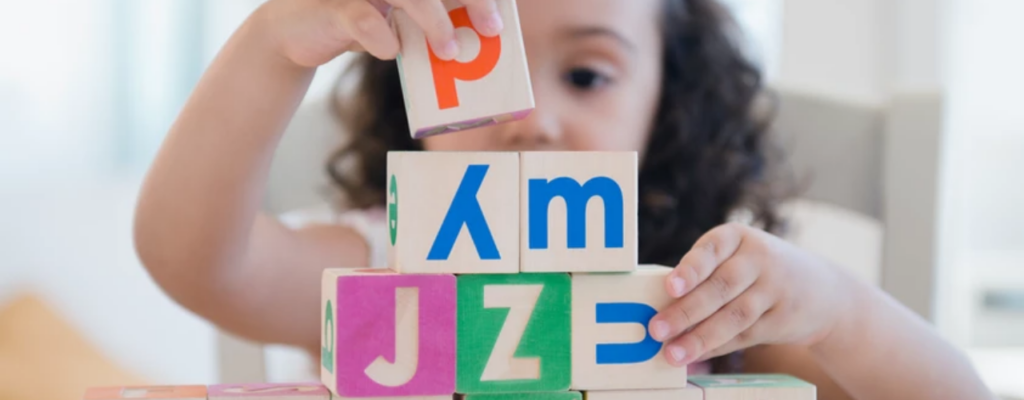Eliciting Language Through Play

by Laura Ironman, MS, CCC-SLP
Toys have shifted a lot as technology advances, but we don’t need toys that talk to our kids to help with communication. These toys listed are great examples of how it’s important to engage with our kids in a variety of ways to help language grow! Don’t let your toy do the talking for you or your child!
Emerging language (0-1 year)
Toy Mirrors:
Babies love looking at themselves, and it’s a great way of starting joint attention. Joint attention is the act of looking at something and then looking at the other person to confirm you are both attending to the same item. It’s typically known as the first step to communication in infants! Communication happens before they even say their first word! You can model joint attention by looking at your baby, looking at the mirror and looking back at the baby.
Shape Sorters:
Shape sorters are a great way to flex some executive function muscle and to begin labeling simple shapes and colors while using simple language. For example: blue square, yellow circle, and so on…
Babies love looking at themselves, and it’s a great way of starting joint attention. Joint attention is the act of looking at something and then looking at the other person to confirm you are both attending to the same item. It’s typically known as the first step to communication in infants! Communication happens before they even say their first word! You can model joint attention by looking at your baby, looking at the mirror, and looking back at the baby.
Early Language (1-2 years)
Bubbles:
Playing with a ball is another simple toy that can be jazzed up with some repeated language and the introduction of action words, too (e.g. roll ball, bounce ball, etc.). Repeated, short phrases are a great way of beginning to teach language to your kids!
Ball:
Playing with a ball is another simple toy that can be jazzed up with some repeated language and the introduction of action words, too (e.g. roll ball, bounce ball, etc.).
Wind up toys:
This is another example of a toy that children typically love and you can repeat the action over and over, keeping the language similar each time. This intentional use of natural repetition will help teach that language to the child!
Puzzles:
Dollhouses and cartoon themed playhouses are excellent ways to start to pretend play. Making eating noises and saying things like “Dolly eat” allow children to act out different scenarios and practice language. Playhouses are advantageous because children tend to mimic familiar household routines – eating, sleeping, cooking, taking a bath, etc.s are all modes of transportation). For younger children, caregivers can label the puzzle pieces and also add to it. Getting creative with how you can describe each puzzle piece will help solidify learning. For example, if you are categorizing farm animals, add their animal sounds as well (the horse says neigh and the horse eats hay).
Later language (2 years and up)
Play Houses:
Dollhouses and cartoon themed playhouses are excellent ways to start to pretend play. Making eating noises and saying things like “Dolly eat” allow children to act out different scenarios and practice language. Playhouses are advantageous because children tend to mimic familiar household routines – eating, sleeping, cooking, taking a bath, etc.
Dollhouses and cartoon themed playhouses are excellent ways to start to pretend play. Making eating noises and saying things like “Dolly eat” allow children to act out different scenarios and practice language. Playhouses are advantageous because children tend to mimic familiar household routines – eating, sleeping, cooking, taking a bath, etc.
Dollhouses:
Dollhouses and cartoon themed playhouses are excellent ways to start to pretend play. Making eating noises and saying things like “Dolly eat” allow children to act out different scenarios and practice language. Playhouses are advantageous because children tend to mimic familiar household routines – eating, sleeping, cooking, taking a bath, etc.
Toy Foods:
Teach your little chef more language while playing with food! Pretend food play offers a variety of scenarios and opportunities to model and encourage language. Caregivers can practice problem-solving skills by having your child order a meal and consider ways they might make that meal. Kids can make silly recipes and talk about why they are silly. For example: It’s silly to put apples on a pizza because apples are sweet – that would not taste very yummy!”
Stuffed Animals:
Stuffed animals are great not only for comfort, but can be an opportunity for more pretend play and language! Have the stuffed animal act out different actions – maybe it is dancing or eating. You can also play charades with your child and the stuffed animal. When things turn into a game, it’s incredibly motivational for a child.
Doctors Kits:
Doctors Kits are another great pretend play activity that is great for language. It also offers a repeated routine that your child is likely familiar with: “going to the doctor.” Pretending to have a “boo-boo” and listening to your “patient’s” heart beat are fun ways to narrate a doctors visit and practice asking and responding to various familiar questions.


